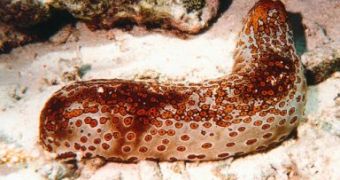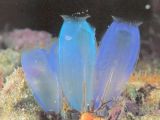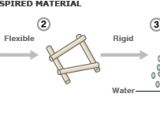One day, diseased brains may be cured. And I'm not referring to going to a shrink or taking pills. The sea cucumber skin has been the inspiration for a new material that may treat Parkinson's disease and other damages of the nervous tissue. This material could rapidly change from rigid to flexible and vice versa.
The new research published in the journal "Science" describes the new material that could act like advanced brain electrodes which are stiff when implanted, but turn soft inside the brain, in contact with water (the brain is made 75% of water). "The water acts as a chemical switch," lead researcher Dr. Christoph Weder told the BBC News.
The new material is made of natural cellulose nanofibres embedded in a polymer. The fibers have only 25 nanometers in diameter and come from a sessile sea animal called tunicate, or sea squirt. Tunicates are related to vertebrates and are the only animals that synthesize cellulose (the most common plant material in nature).
"There are many sources of nanofibers such as cotton or wood [which could be substituted]," said Weder.
Instead, the sea cucumber skin has collagen nanofibres embedded in a soft connective tissue.
"These creatures can reversibly and quickly change the stiffness of their skin. Normally it is very soft; but for example in response to a threat, the animal can activate its 'body armor' by hardening its dermis," said co-researcher Dr. Jeffrey Capadona.
The sea cucumber changes its skin texture via chemicals released by the animal's nervous system that rearrange the collagen fibers.
"Our architecture is the same, but the chemistry is different," said Weder.
Without water, the nanofibres stay together due to the hydrogen bonds that make the material stiff. But the water molecules "competitively bond" with the fibers when these are soaked.
"The water also likes to stick to the cellulose," said Weder.
This turns the material up to 1,000 times softer, having the texture of a rubber. The evaporation of the water leaves a stiff network of cross-linked fibers behind. The material could be used for brain therapeutic implants, in cases of Parkinson's disease, stroke or spinal cord injuries.
Animal experiments with implanted electrodes have been made for increasing electrical activity in the brain cortex, but the quality of the brain signals triggered by these electrodes often degrades after several months. It seems that stiff electrodes harm the surrounding brain tissue.
"There is a mechanical mismatch - the electrode is rigid but the brain is more like jello," said Weder. The new material could bypass this issue. For other applications, the team searches for switching states of the material, using electricity rather than water.
"Smart bullet proof vests, prosthetics - the list goes on and on," said Weder about possible applications.

 14 DAY TRIAL //
14 DAY TRIAL // 

